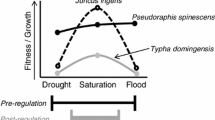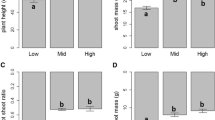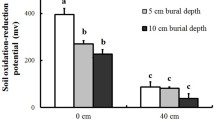Abstract
Riverine floodwater pulses provide water, nutrients, and sediments to floodplain wetlands, but flood pulses also act as a natural disturbance by removing biomass, scouring sediments, and delivering turbid waters. We investigated nearly pristine montane floodplain wetlands with varying degrees of river connectivity in Jasper National Park, Canada: three fully connected riverine marshes, three partially connected beaver-impounded marshes, and three completely disconnected railway-impounded marshes. Our objectives were to determine how river connectivity affects plant biomass and water and sediment chemistry, estimate impacts of nutrient limitations on plant biomass, and compare natural variations in river flooding on plant biomass and nutrients. The amplitude of water level fluctuations, a measure of flood disturbance and river connectivity, was highest in flood years and in riverine marshes. Sites with river connectivity had significantly higher plant biomass than sites without river connectivity (railway-impounded marshes).NO3 −−N, TP, and turbidity correlated positively with river floodwater pulses. A high flood year increased nutrient supply in the wetland water but significantly decreased plant biomass in all sites. Moderate flood disturbance and nutrient inputs from floodwaters provided optimal growing conditions for plants in these montane floodplain marshes.
Similar content being viewed by others
Literature Cited
Amoros, C., G. Bornette, and C. P. Henry. 2000. A vegetation-based method for ecological diagnosis of riverine wetlands. Environmental Management 25:211–27.
Auclair, A. N. D., A. Bouchard, and J. Pajaczkowski. 1976. Productivity relations in aCarex-dominated ecosystem. Oecologia 26:9–31.
Bayley, P. B. 1995. Understanding large-river floodplain ecosystems. BioScience 45:153–58.
Bayley, S. E. and J. K. Guimond. 2008. Effects of river connectivity on marsh vegetation community structure and species richness in montane floodplain wetlands in Jasper National Park, Alberta, Canada. Écoscience 15:377–88.
Bayley, S. E. and R. L. Mewhort. 2004. Plant community structure and functional differences between marshes and fens in the southern boreal region of Alberta, Canada. Wetlands 24:277–94.
Bedford, B. L., M. R. Walbridge, and A. Aldous. 1999. Patterns in nutrient availability and plant diversity of temperate North American wetlands. Ecology 80:2151–69.
Bernard, J. M., D. Solander, and J. Kvêt. 1988. Production and nutrient dynamics inCarex wetlands. Aquatic Botany 30: 125–47.
Bierhuizen, J. F. H. and E. E. Prepas. 1985. Relationship between nutrient, dominant ions, and phytoplankton standing crop in prairie saline lakes. Canadian Journal of Fisheries and Aquatic Sciences 42:1588–94.
Boyd, C. E. 1971. Further studies on productivity, nutrient, and pigment relationships inTypha latifolia populations. Bulletin of the Torrey Botanical Club 98:144–50.
Bray, J. R. 1963. Root production and the estimation of net productivity. Canadian Journal of Botany 41:65–72.
Campbell, C., D. H. Vitt, L. A. Halsey, I. D. Campbell, M. N. Thormann, and S. E. Bayley. 2000. Net primary production and standing biomass in northern continental wetlands. Canadian Forest Service, Northern Forestry Centre, Edmonton, AB, Canada. Information Report NOR-X-369.
Cook, B. J. and F. R. Hauer. 2007. Effects of hydrologic connectivity on water chemistry, soils, and vegetation structure and function in an intermontane depressional wetland landscape. Wetlands 27:719–38.
Environment Canada. 1999. HYDAT CD-ROM. Water Survey of Canada, Ottawa, ON, Canada.
Environment Canada. 2004. Canadian Climate Normals, 1971–2000. Canadian Climate Program, Ottawa, ON, Canada.
Gorham, E. and M. G. Somers. 1973. Seasonal changes in the standing crop of two montane sedges. Canadian Journal of Botany 51:1097–108.
Gosselink, J. G. and R. E. Turner. 1978. The role of hydrology in freshwater wetlands ecosystems. p. 63–78.In R. E. Good, D. F. Whigham, and R. L. Simpson (eds.) Freshwater Wetlands: Ecological Processes and Management Potential. Academic Press, New York, NY, USA.
Holland, W. D. and G. M. Coen. 1982. Ecological (Biophysical) land classification of Banff and Jasper National Parks. Volume II: Soil and vegetation resources. Alberta Institute of Pedology, Ottawa, ON, Canada. Publication SS-82-44.
Hopkinson, C. S., J. G. Gosselink, and R. T. Parrando. 1978. Aboveground production of seven marsh plant species in coastal Louisiana. Ecology 59:760–69.
Hudon, C. 1997. Impacts of water level fluctuations on St. Lawrence River aquatic vegetation. Canadian Journal of Fisheries and Aquatic Sciences 54:2853–65.
Johnson, B. J., W. B. Richardson, and T. J. Naimo. 1995. Past, present, and future concepts in large river ecology. BioScience 45:134–41.
Johnston, C. A., S. D. Bridgham, and J. P. Schubauer-Berigan. 2001. Nutrient dynamics in relation to geomorphology of riverine wetlands. Soil Science Society of America Journal 65:557–77.
Junk, W. J., P. B. Bayley, and R. E. Sparks. 1989. The flood pulse concept in river-floodplain systems. p. 110–27.In D. P. Dodge (ed.) Proceedings of the International Large River Symposium, Toronto, ON, Canada, 14–21 September 1986. Canadian Special Publication of Fisheries and Aquatic Sciences 106, Department of Fisheries and Oceans, Ottawa, ON, Canada.
Laitenen, J. 1990. Periodic moisture fluctuation as a factor affecting mire vegetation. Aquilo Series Botanica 28:45–55.
Lesack, L. F. W., P. Marsh, and R. E. Hecky. 1998. Spatial and temporal dynamics of major solute chemistry among Mackenzie Delta Lakes. Limnology and Oceanography 43:1530–43.
Lewis, W. M. and M. C. Grant. 1979. Relationships between stream discharge and yield of dissolved substances from a Colorado mountain watershed. Soil Science 128:353–63.
Makaske, B. 2001. Anastomosing rivers: a review of their classification, origin and sedimentary products. Earth Science Reviews 53:14–96.
Menzel, D. W. and N. Corwin. 1965. The measurement of total P in seawater based on liberation of organically bound fractions by persulfate oxidation. Limnology and Oceanography 10:280–82.
Mitsch, W. J. and J. G. Gosselink. 2000. Wetlands, third edition. John Wiley and Sons, Inc., New York, NY, USA.
Naiman, R. J., H. Décamps, and M. M. Pollock. 1993. The role of riparian corridors in maintaining regional biodiversity. Ecological Applications 3:209–12.
Poff, L. N., J. D. Allan, M. B. Bain, J. R. Karr, K. L. Prestegaard, B. D. Richter, R. E. Sparks, and J. C. Stromberg. 1997. The natural flow regime: a paradigm for river conservation and restoration. BioScience 47:769–84.
Pollock, M. M., R. J. Naiman, and T. A. Haney. 1998. Plant species richness in riparian wetlands — a test of biodiversity theory. Ecology 79:94–105.
Redfield, A. C. 1958. The biological control of chemical factors in the environment. American Scientist 46:205–21.
Robertson, A. I., P. Bacon, and G. Heagney. 2001. The responses of floodplain primary production to flood frequency and timing. Journal of Applied Ecology 38:126–36.
Sharitz, R. R., L. R. Boring, D. H. van Lear, and J. E. Pinder, III. 1992. Integrating ecological concepts with natural resource management of southern forests. Ecological Applications 2:226–37.
Sokal, R. R. and F. J. Rohlf. 1995. Biometry: the Principles and Practice of Statistics in Biological Research, third edition. W. H. Freeman and Company, New York, NY, USA.
Sparks, R. E. 1995. Need for ecosystem management of large rivers and their floodplains. BioScience 45:168–82.
Thormann, M. N. and S. E. Bayley. 1997. Aboveground net primary production along a bog-fen-marsh gradient in southern boreal Alberta, Canada. Écoscience 4:374–84.
Tockner, K., D. Pennetzdorfer, N. Reiner, F. Schiemer, and J. W. Ward. 1999. Hydrologic connectivity, and the exchange of organic matter and nutrients in a dynamic river-floodplain system (Danube, Austria). Freshwater Biology 41:521–35.
van der Valk, A. G. and C. B. Davis. 1978. Primary production of prairie glacial marshes. p. 21–38.In R. E. Good, D. F. Whigham, and R. L. Simpson (eds.) Freshwater Wetlands: Ecological Processes and Management Potential. Academic Press, New York, NY, USA.
van Oorschot, M., E. Robbemont, M. Boerstal, I. van Strien, and M. van Kerkhoven-Schmitz. 1997. Effects of enhanced nutrient availability on plant and soil nutrient dynamics in two English riverine ecosystems. Journal of Ecology 85:167–79.
Verhoeven, J. T. A., W. Koerselman, and A. F. M. Meuleman. 1996. Nitrogen- or phosphorus-limited growth in herbaceous, wet vegetation: relations with atmospheric inputs and management regimes. Trends in Ecology and Evolution 11:494–97.
Wetzel, R. G. 2001. Limnology. Lake and River Ecosystems, third edition. Academic Press, San Diego, CA, USA.
Wilcox, D. A. 1995. Wetland and aquatic macrophytes as indicators of anthropogenic hydrologic disturbance. Natural Areas Journal 15:240–48.
Wilson, S. D. and P. A. Keddy. 1985. Plant zonation on a shoreline gradient: physiological response curves of component species. Journal of Ecology 73:851–60.
Wisheu, I. C. and P. A. Keddy. 1989. Species richness — standing crop relationships along four lakeshore gradients: constraints on the general model. Canadian Journal of Botany 67:1609–17.
Wray, H. E. and S. E. Bayley. 2007. Denitrification rates in marsh fringes and fens in two boreal peatlands in Alberta, Canada. Wetlands 27:1036–45.
Author information
Authors and Affiliations
Corresponding author
Rights and permissions
About this article
Cite this article
Bayley, S.E., Guimond, J.K. Aboveground biomass and nutrient limitation in relation to river connectivity in montane floodplain marshes. Wetlands 29, 1243–1254 (2009). https://doi.org/10.1672/08-227.1
Received:
Accepted:
Issue Date:
DOI: https://doi.org/10.1672/08-227.1




